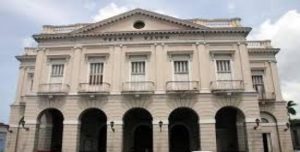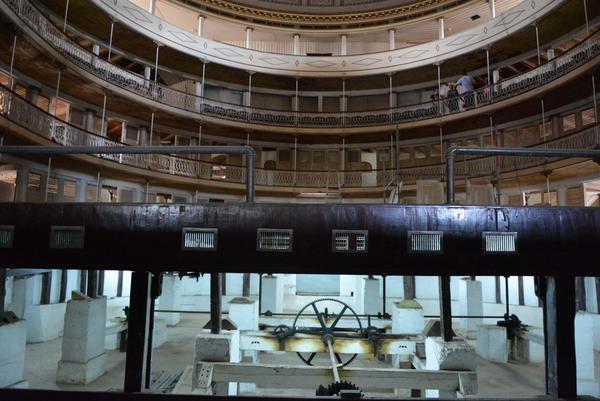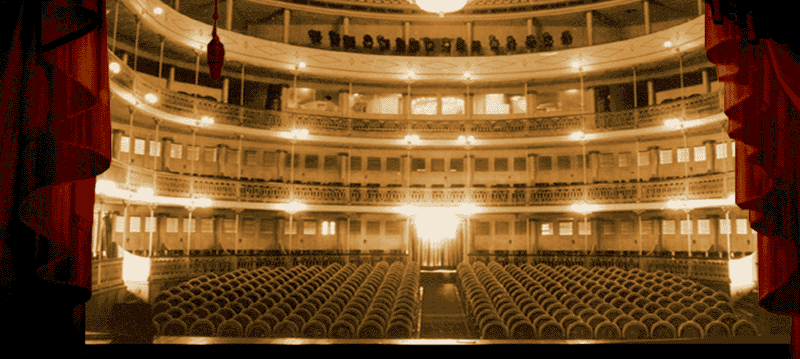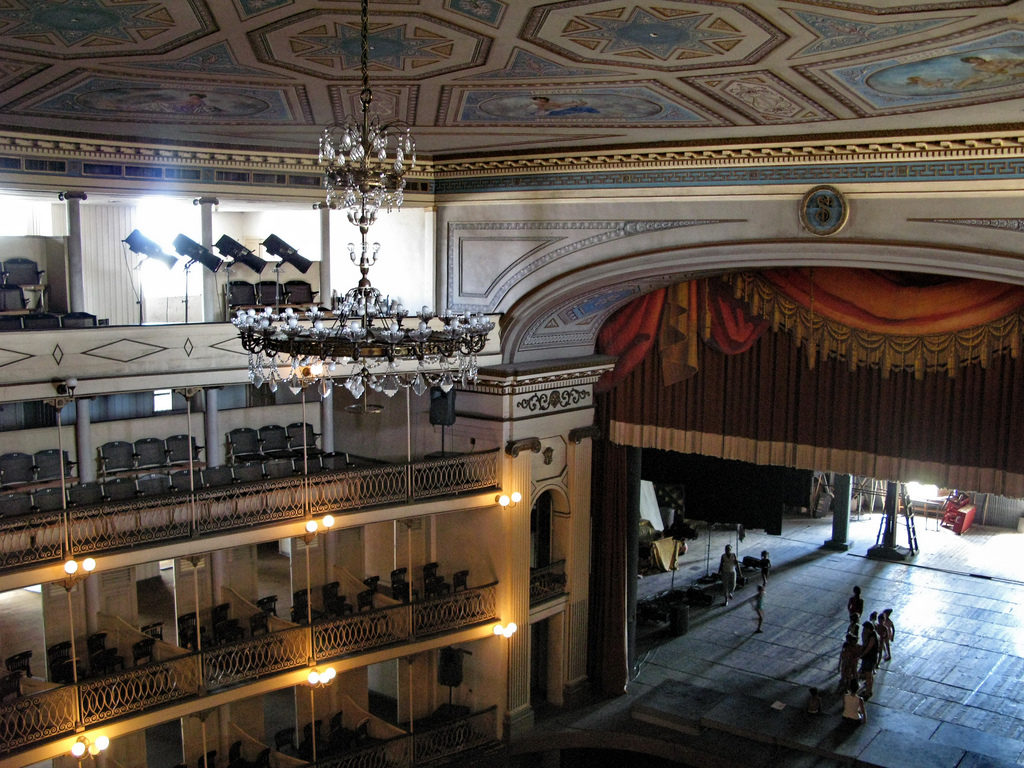THE SAUTO THEATER, MATANZAS: THE MOST RELEVANT THEATRICAL COLISEUM OF CUBA IS BORN AGAIN.
The Sauto Theater, National Monument and one of the most important theaters of Cuba, recognized by the inhabitants of Matanzas as a symbol of the city for its architectural splendor and the hierarchy of the artists who have acted on its stage will fulfill years of its inauguration and current restoration; that goes through the final stage of restoration while waiting for the essential equipment of air conditioning, sound, lights, and the general electric blackboard.
From October 1858, in the heat of the influence of the Philharmonic Society, the dream of the Matanceros began to take shape rapidly: funds were collected among the landowners, merchants and owners, proposals were discussed, the Governor of the Island himself announced in the press his authorization to start the work that ends opening on April 6, 1863.
The Coliseum heads the trilogy of classic Cuban theaters. The imposing building is a faithful example of the neoclassical style, impressive for its scale and stylistic treatment. It has four very well resolved and appreciable facades from any point you look at it. It stands out among all, the main facade, of Ionian style, with portico and a high plant of similar nobility; all crowned by a rectilinear pediment of central oculus. In the lateral facades the gallery of the smokers stands out. This area introduces a note of depth and shadow, between the front and the part occupied by the dressing rooms, thus achieving a pleasant balance. On the other hand, the posterior facade, of Doric order, is also characterized by the sobriety of the treatment in the wall. Once inside, the theater surprises with functionality, the relationship established between the different spaces, and the sober, though detailed, decoration. Due to its horseshoe shape, the room is included in the family of theaters “a la italiana”.
Famous for its great acoustics, on the stage of the Sauto have presented great artistic figures, both Cuban and foreign, including the Prima Ballerina Assoluta Alicia Alonso, the Russian, of similar renown, Anna Pavlova, the tenor Enrico Caruso, the actress Sara Bernhardt, the Cuban musician Ernesto Lecuona, the dramatist and Nobel Literature Prize winner Jacinto Benavente, the actress and singer Libertad Lamarque the Spanish dancer, Antonio Gades, and the composer, guitarist and conductor Leo Brouwer. The great chess player José Raúl Capablanca played a simultaneous game in his rooms. Headquarters of extraordinary historical events, such as having played for the first time in public the Anthem of Bayamo in 1899.
Legend has it that in the Sauto Theater, the figures of art that gave it glory return to the stage. One of the legends states that Anna Pavlova herself still dances between the curtains and moves between the shadows of the stairs. Snowball returns to the piano to shed its melodies, and you hear the bell that played its owner, Sauto, when he wanted to return order to the spectators. Row six, and specifically the first chair, is the place of best acoustics, without having explained the physical factors that determine this uniqueness. They say that there sits a Chinese of unknown name, one of the many Asians who from the quarries extracted the songs with which the theater was built, and then walks through the lunettes to enjoy the fruit of their effort.
National Monument.
In a country where there are formidable theaters, the Matanzas Coliseum, is recognized, however, because until now in its restoration has been strictly respected its architecture, its interior design, its original wooden curtain, which represents the bridge of La Concordia, which crosses the Yumurí River. The Sauto is a paradigm of the great works of art of Cuban culture. That is why it is declared a National Monument, by Resolution # 003, of October 10, 1978, with degree of protection I.
The installation is an architectural jewel, conceived as the harmonic box of a musical instrument. Its acoustics is considered perfect. The style used by the artist recalls, in numerous details, the Scala in Milan. Among other singularities of the “Sauto”, it stands out that it has the original machinery to elevate its platea at the stage level, unique of its type conserved in Cuba and manufactured by an English company by order of the own architect Dall ‘Aglio.
After finishing the restoration of the second headquarters of the old local Artistic and Literary Lyceum, now as the José White Concert Hall, the expectation grows among the inhabitants of Matanzas to return to occupy a seat in a Sauto Theater again dazzling to feel that they traveled in the time.
 EL TEATRO SAUTO, MATANZAS: EL COLISEO TEATRAL MÁS RELEVANTE DE CUBA CUMPLE AÑOS.
EL TEATRO SAUTO, MATANZAS: EL COLISEO TEATRAL MÁS RELEVANTE DE CUBA CUMPLE AÑOS.
El Teatro Sauto, Monumento Nacional y uno de los coliseos teatrales más relevantes de Cuba, reconocido por los habitantes de Matanzas como un símbolo de la ciudad por su esplendor arquitectónico y la jerarquía de los artistas que han actuado en su escenario cumplirá 155 años de su inauguración y actual restauración; que transita por la etapa final de una minuciosa restauración a la espera del equipamiento esencial de climatización, sonido, luces, y la pizarra eléctrica general..
A partir de octubre de 1858, al calor de la influencia de la Sociedad Filarmónica, comienza a perfilarse aceleradamente el sueño de los matanceros: se colectan fondos entre los hacendados, comerciantes y propietarios, se discuten propuestas, el propio Gobernador civil de la Isla anunció en la prensa su autorización para iniciar la obra que termina inaugurandose el 6 de abril de 1863.
El coliseo encabeza la trilogía de teatros clásicos cubanos. El imponente edificio resulta un fiel ejemplo del estilo neoclásico, impresionando por su escala y tratamiento estilístico. Presenta cuatro fachadas muy bien resueltas y apreciables desde cualquier punto que se le mire. Destaca entre todas, la fachada principal, de estilo jónico, con pórtico y una planta alta de similar nobleza; todo coronado por un frontón rectilíneo de óculo central. En las fachadas laterales se destaca la galería de los fumaderos. Dicha área introduce una nota de profundidad y sombra, entre las partes del frente y la que ocupan los camerinos, lográndose así un agradable equilibrio. Por su parte la fachada posterior, de orden dórico, se caracteriza asimismo por la sobriedad del tratamiento en el muro. Ya en el interior, el teatro sorprende por la funcionalidad, la relación que se establece entre los distintos espacios, y la sobria, aunque detallada, decoración. Por su forma de herradura la sala se incluye en la familia de teatros “a la italiana”.
Famoso por su estupenda acústica, en el escenario del Sauto se han presentado grandes figuras artísticas, tanto cubanas como extranjeras, entre ellas la Prima Ballerina Assoluta Alicia Alonso, la rusa, de similar renombre, Anna Pavlova, el tenor Enrico Caruso, la actriz Sara Bernhardt, el músico cubano Ernesto Lecuona, el dramaturgo y Premio Nobel de Literatura Jacinto Benavente,la actriz y cantante Libertad Lamarque el bailarín español, Antonio Gades, y el compositor, guitarrista y director de orquesta Leo Brouwer. El genial ajedrecista José Raúl Capablanca jugó una partida simultánea en sus salas. Sede de extraordinarios hechos históricos, como haberse entonado por vez primera en público el Himno de Bayamo en 1899.
Cuenta la leyenda que en el Teatro Sauto, vuelven al escenario las figuras del arte que le dieron gloria. Una de las leyendas afirma que la propia Anna Pavlova danza aún entre los cortinajes y se desplaza entre las sombras de las escaleras. Bola de Nieve vuelve al piano a desgranar sus melodías, y se escucha la campanilla que tocaba su propietario, Sauto,cuando quería volver al orden a los espectadores. La fila seis, y específicamente la primera silla, resulta el lugar de mejor acústica, sin que se haya explicado los factores físicos que determinan esta singularidad. Cuentan que allí se sienta un chino de nombre desconocido, uno de los tantos asiáticos que de las canteras extrajeron los cantos con que se edificó el teatro, y luego pasea por entre las lunetas para disfrutar del fruto de su esfuerzo.
Monumento Nacional.
En un país donde existen formidables teatros, el coliseo matancero, se reconoce, sin embargo, porque hasta la actualidad en su restauración se ha respetado estrictamente su arquitectura, su diseño interior, su telón original de madera, en el que se representa el puente de La Concordia, que cruza el río Yumurí. El Sauto es un paradigma de las grandes obras de arte de la cultura cubana. Es por todo ello que es declarado Monumento Nacional, por la Resolución # 003, del 10 de octubre de 1978, con grado de protección I.
La instalación es una joya arquitectónica, concebida como la caja armónica de un instrumento musical. Su acústica se considera perfecta. El estilo utilizado por el artista recuerda, en numerosos detalles, a la Scala de Milán. Entre otras singularidades del “Sauto”, destaca que cuenta con la maquinaria original para elevar su platea a nivel del escenario, única de su tipo conservada en Cuba y fabricada por una compañía inglesa por encargo del propio arquitecto Dall’ Aglio.

En el teatro Sauto, maestros artesanos lograron activar la antigua maquinaria para elevar la platea al nivel del escenario, única de su tipo que aún funciona en una institución escénica de Cuba. Matanzas, Cuba, 6 de abril de 2016. ACN FOTO/Roberto Jesús HERNÁNDEZ/sdl
Luego de concluir la restauración de la segunda sede del antiguo Liceo Artístico y Literario local, ahora como Sala de Conciertos José White, crece la expectación entre los habitantes de Matanzas por volver a ocupar una butaca en un Teatro Sauto otra vez deslumbrante para sentir que viajaron en el tiempo.
Agencies/Wiki/Ecured/Various/ Internet Photos/ Arnoldo Varona/ TheCubanHistory.com
THE CUBAN HISTORY, HOLLYWOOD.









